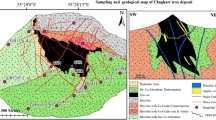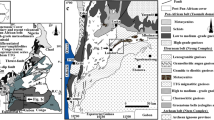Abstract
In the Pötürge (Malatya, Turkey) area pyrophyllite occurrences are common in the shear zones, mostly in the form of lenses along faults. Mineralogical investigations (XRD, FTIR and SEM) revealed that pyrophyllite, kaolinite (dickite) and quartz are present in the form of major phases and muscovite (sericite), kyanite, chlorite, and alunite are only present in the form of minor phases.
This study revealed that the existence of the kyanite phase points out to high pressure and temperature conditions which the rocks were underwent. On the other hand, the minerals such as pyrophyllite, kaolinite, and alunite are products of a low degree metamorphism (retrograde). The mineral paragenesis in the pyrophyllite deposits suggests that the formation of minerals took place in two ways: (1) the transformation of kyanite into pyrophyllite and quartz through retrograde metamorphism by a high degree temperature, (2) then pyrophyllite and probably muscovite were transformed into kaolinite and alunite through reactions with relatively low temperature hydrothermal fluids.
The geochemical data indicate that during the retrograde metamorphism the elements K, Rb, Sr, Ba, S, and Fe were mobile, the elements Si, Al, P moderately mobile to immobile and the HPS elements (Zr, Ti, and Nb) were immobile. It was shown that the formation of pyrophyllite, kaolinite and alunite was associated with depletion in alkalis, Mg, Fe and enrichment of elements including Sr, Ba, and S. Mineralogical and geochemical data suggest that parent rocks (pre-metamorphism) of the Pötürge pyrophyllite were probably kaolinite, Al-rich clays or bauxites.
Similar content being viewed by others
References
P. W. Harben, “Minerals and Chemicals Round-Up,” in Raw Materials for the Oilwell Drilling Industry, Ed. by P.W. Harben (Metal. Bull., London, 1978), pp. 75–81.
P. W. Harben and R. L. Bates, Geology of the Nonmetallics (Metal. Bull., New York. 1984).
N. Fuji, The Present Position of Japanese Pyrophyllite, Indust. Mineral. 194, 21–27 (1983).
K. N. Sang, “Pyrophyllite Clay Deposits in the Republic of Korea,” Indust. Mineral. 194, 30–31 (1983).
Martha L. Sykes and B. Judith Moody, “Pyrophyllite and Metamorphism in the Carolina Slate Belt,” Am. Mineral. 63, 96–108 (1978).
A. Taş, Malatya Pötürge Yöesi Profillit Yataklarinin Jeokimyasi ve Olu umu. Yuksek Lisans Tezi, ME. U. Fen. Bil. Enst. Jeoloji Anabilim Dal, (2002)
L. E. Ricou, I. Agyriadis, and J. Marcoux, “L’ axe Calcaire du Taurus, un Alignement de Denetres Arabo-Africaines Sous Des Nappes radiolaritiques, ophiolitiques et metamorphiques,” Bull. Soc. Geol. Fr. 7, 1024–1044 (1975).
A. Michard, H. Whitechurch, L. E. Ricou, R. Montigny, and E. Yazgan, Tauric Subduction (Malatya-Elazi Provinces) and its Bearing on Tectonics of the Tethyan Realm in Turkey: Presented during the Meeting on the Geological Evolution of the Eastern Mediterranean (Edinburgh, 1982).
E. Yazgan, “Geodynamic Evolution of the Eastern Taurus Region,” International Symposium on the Geology of the Taurus Belt, Ankara, Turkey, 1983 (Ankara, 1983), pp. 199–208.
E. Yazgan, A. Michard, H. Whitechurch, and R. Montigny, “Le Taurus de Malatya (Turquie orientale), Element de la Suture Sud-Tethysienne,” Bull. Soc. Geol. France, No. 1, 59–69 (1983).
E. Erdem, “Pötürge (Malatya) Metamorfitlerinin Petrografik ve Petrolojik Özellikleri,” Doktora Tezi, Firat Unv. Fen Bilimleri Enstitüsü, Elazi (1994).
E. Erdem and A. F. ve Bingol, “Pötürge (Malatya) Masifindeki Gnayslarin Petrografik ve Petrolojik,” Ozellikleri Sel uk üniv. Müh. Fak. 20. Yil Jeol. Semp. Bild. 217–227 (1997).
M. J. Wilson, “A Handbook of Determinative Methods in Clay Mineralogy,” (Chapman and Hall, New York, 1987).
V. C. Farmer, “The Layer Silicates,” in The Infrared Spectra of Minerals, Ed. by V. C. Farmer (Mineral. Soc., London, 1974), pp. 331–365.
A. Steckeisen, “To Each Plutonic Rock its Proper Name,” Earth Sci. Rev. 12, 1–34 (1976).
H. G. F. Winkler, “Petrogenesis of Metamorphic Rocks,” (Springer Verlag, Heidelberg, 1976).
H. W. Day, “A Working Model of Some Equilibria in the System Alumina-Silica-Water,” Am. J. Sci. 276, 1254–1284 (1976).
H. Haas and M. J. Holdaway, “Equilibrium in the system Al2O3-SiO2-H2O Involving the Stability Limits of Pyrophyllite and Thermodynamic Data of Pyrophyllite,” Am. J. Sci. 273, 449–464 (1973).
J. J. Hemley, J. W. Montaya, J. W. Marenko, and J. W. Luce, “Equilibrium in the System Al2O3-SiO2-H2O and Some General Implications for Alteration Mineralization Processes,” Econ. Geol. 75, 210–288 (1980).
H. G. Dill, H. -R. Bosse, and J. Kassbohm, “Mineralogical and Chemical Studies of Volcanic-Related Argillaceous Industrial Minerals of the Central American Cordillera, Western El Salvador,” Econ. Geol. 95, 517–538 (2000).
U. Barth-Wirsching and H. Hoeller, “Experimental Studies on Zeolite Formation Conditions,” Eur. J. Mineral., Nos. 1–4, 489–506 (1989).
H. G. Dill, “The Geology of Aluminium Phosphates and Sulphates of the Alunite Supergoup: A Review,” EarthSci. Rev. 53, 25–93 (2001).
R. Ek and P. Nysten, “Phosphate Mineralogy of the Höalsjöberg and Hökensås Kyanite Deposits,” Geol. Foren. Stockholm Forh. 112, 9–18, (1990).
T. Finlow-Bates and E. F. Stumpfl, “The Behaviour of So-Called Immobile Elements in Hydrothermally Altered Rocks Associated with Volcanogenic Submarine-Exhalative Ore Deposits,” Mineral. Deposita 16, 319–328 (1981).
H. Haas and M. J. Holdaway, Equilibrium in the System Al2O3-SiO2-H2O Involving the Stability Limits of Pyrophyllite, Am. J. Sci. 273, 449–464 (1973).
B. L. Weaver and J. Tarney, “Lewisian gneiss geochemistry and Archean development models,” Earth Planet. Sci. Lett. 55, 171–180, (1981).
W. H. MacLean, and P. Kranidiotis, “Immobile elements as monitors of mass transfer in hydrothermal alteration: Phelps Dodge massive sulfide deposit, Matagami, Quebec,” Econ. Geol. 82, 951–962, (1987).
D. J. Whitford, W. P. A. Mcpherson, and D. B. Wallace, “Geochemistry of the Host Rock of the Volcanogenic Massive Sulfide Deposit at the Que Riber, Tasmania,” Econ. Geol. 84, 1–21 (1989).
R. K. Vance and K. C. Condie, “Geochemistry of Footwall Alteration Associated with the Early Proterozioc United Verde Massive Sulfide Deposit, Jerome, Arizona,” Econ. Geol. 82, 571–586, (1987).
W. H. MacLean and T. J. Barretti, “Lithogeochemical Methods using Immobile Elements,” J. Explor. Geochem. 48, 109–133 (1993).
R. L. Cullers, M. J. DiMarco, D. R. Lowe, and J. Stone, “Geochemistry of a Silicified, Felsic Volcaniclastic Suite from the Early Archaean Panorama Formation, Pilbara Block, Western Australia: an Evaluation of Depositional and Post Depositional Processes with Special Emphasis on the Rare Earth Elements,” Precambrian Res. 60, 99–116 (1993).
G. M. Dipple, R. P. Wintsch, and M. S. Andrews, “Identification of the Scales of Differential Element Mobility in a Ductile Fault Zone,” J. Metamorph. Geol. 8, 645–661, (1990).
B. Moine, J. P. Fortune, P. Moreau, and F. Viguier, “Comparative Mineralogy, Geochemistry, and Conditions of Formation of Two Metasomatic Talc and Chlorite Deposits: Trimouns (Pyrenees, France) and Rabenwald (Eastern Alps, Austria),” Econ. Geol. 84, 1398–1416 (1989).
H. J. Stahle, M. Raith, S. Hoernes, and A. Delfs, “Element Mobility during Incipient Granulite Formation at Kabbaldurga, S. India,” J. Petrol. 28, 803–834, (1987).
R. D. Vocke, G. N. Hanson, and M. Grunenfelder, “Rare Earth Mobility in the Roffna Gneiss, Switzerland,” Contrib. Mineral. Petrol. 95, 145–154, (1987).
A. P. Dicken, “Evidence for Limited REE Leaching from the Roffna Gneiss, Switzerland-A Discussion of the Paper by Vocke et al. (1987)” Contrib. Mineral. Petrol. 99, 273–275 (1988).
K. O’Hara, “State of Strain in Mylonites from the Western Blue Ridge Province, Southern Appalachians: the Role of Volume Loss,” J. Struct. Geol., 12, 419–430 (1990).
A. F. Glazner and J. M. Bartley, “Volume Loss, Fluid Flow and Strain in Extensional Mylonites from the Central Mojave Desert, California,” J. Struct. Geol. 13, 587–694 (1991).
R. L. Gresens, “Composition-Volume Relationships of Metasomatism,” Chem. Geol. 2, 47–55 (1967).
J. A. Grant, “The Isocon Diagram-a Simple Solution to Gresens’ Equation for Metasomatic Alteration,” Econ. Geol. 81, 1976–1982 (1986).
J. A. Pearce, N. B. W. Harris, and A. G. Tindle, “Trace Element Discrimination Diagrams for the Tectonic Interpretation of Granitic Rocks,” J. Petrol. 25, 956–983 (1984).
P. Möller and G. Morteani, “On the Geochemical Fractionation of Rare-Earth Elements During the Formation of Ca-Minerals and its Application to Problems of the Genesis of Ore Deposits,” in The Significance of Trace Elements in Solving Petrogenetic Problems and Controversies, Ed. by S. S. Augustithis, (Theophrastus, Athens, 1983), pp. 747–791.
Author information
Authors and Affiliations
Corresponding author
Additional information
The article is published in the original.
Rights and permissions
About this article
Cite this article
Öner, F., Taş, A. Geochemistry, mineralogy and genesis of pyrophyllite deposits in the Pötürge Region (Malatya, Eastern Turkey). Geochem. Int. 51, 140–154 (2013). https://doi.org/10.1134/S0016702913020079
Received:
Accepted:
Published:
Issue Date:
DOI: https://doi.org/10.1134/S0016702913020079




